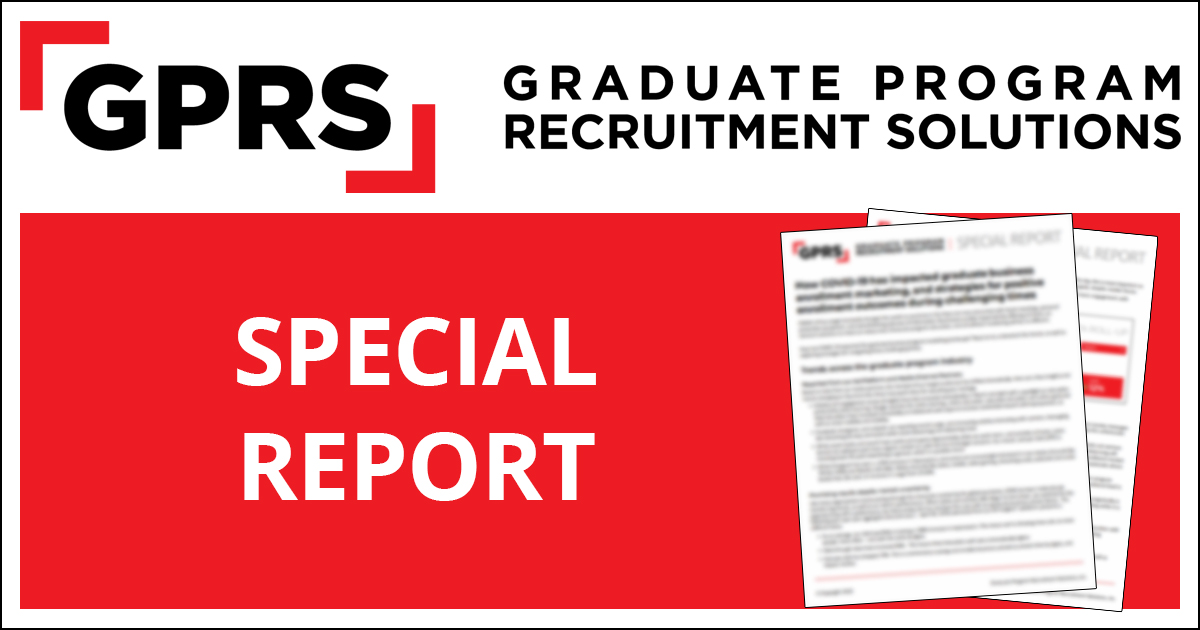Protecting your brand in a time of judgement
 According to Amazon CEO Jeff Bezos, “Branding is what people say about you when you’re not in the room.”
According to Amazon CEO Jeff Bezos, “Branding is what people say about you when you’re not in the room.”
And at the moment, most of us are not “in the room” together. So how, during this pandemic, can higher ed institutions protect their brands when electronic communications are replacing in-person interactions and it’s more important than ever to “get it right”?
A brand identity is a delicate balance of your values, personality, promise, communications and what you want people to feel when they interact with you. Most importantly, it gives people a reason to trust you. But that can change quickly.
In today’s hyper-sensitive environment, just one statement can polarize an entire group and all eyes are on how we react online, in communications and on social media. The brands succeeding are pivoting their communications to address adversity, lead with confidence and emphasize commitment to their students.
Re-evaluating (and enhancing) your brand promise
Although your brand promise can help you sell an educational experience, career development, a network and personal development, right now, it also needs to:
- Display your resilience
- Illustrate corporate social responsibility
- Convey a promise of safety
Brands right now need to go above and beyond. Higher ed institutions are no exception. Returning to the basic tenants of branding with a SWOT analysis can help your school make the necessary communication shifts needed.
- Strengths – positive things that give you an advantage in the market
- Weaknesses – challenges that give you a disadvantage or areas for improvement
- Opportunities – ways you can adapt to capitalize on change
- Threats – things that cause you problems on a larger scale
You may need to expand upon your brand promise and take it a step further to relate it to the current situation. For example, brands in higher education tend to focus on belonging, advancement, personal scale and continuous learning. In a time where prospects are looking for a safe space where they can accomplish their goals, reiterating these ideals can go a long way to strengthen the relationship.
Re-evaluating your target’s needs
What mattered to your audience a few short months ago has most likely changed. Although their core values may remain the same, the situation has dictated an extreme pivot in priorities. If education and career development isn’t on their priority list, your communications can sound tone deaf if they are not addressing their needs. The tricky part is that there are so many opinions swirling around right now relating to COVID and recent events that it’s really difficult to tell where people fall. They may have lost their jobs, may be caring for a family member, homeschooling, attempting to work from home and struggling with uncertainty.
If you don’t want to lose them, a fair dose of empathy and confidence can go a long way. People are being inundated by communications from everywhere. They can check out and unsubscribe if it’s too much. Less is more. Try addressing your prospects’ concerns in a neutral, informational fashion vs. giving opinions – and keep the focus on them.
Communication tips for protecting your brand
- Minimize polarization by keeping things neutral and informational
- Put a hold on opinion pieces right now
- Avoid attachment to political stances and public figures
- Avoid making negative statements – replace with authentic positivity
- Reinforce your brand promise
- Avoid information overload
- Address adversity confidently
- Reassure students, prospects and influencers you are focused on safety
- Use social media carefully
As you navigate this time of uncertainty, lean on partners who have experience in branding, digital presence and messaging. GPRS can help you quickly shift your digital advertising and brainstorm ways to pivot your messaging to protect your most valued asset – your brand.

 When COVID-19 upended the higher ed industry, executive education received a great opportunity on a silver platter. With people at home, conferences being cancelled and more time for professional development, schools offering online learning are successfully finding ways to make up for lost income in other areas.
When COVID-19 upended the higher ed industry, executive education received a great opportunity on a silver platter. With people at home, conferences being cancelled and more time for professional development, schools offering online learning are successfully finding ways to make up for lost income in other areas.  On any given day, your prospects are facing many barriers in the decision-making process of pursuing a graduate program. And now, with the market uncertainty COVID-19 has created, there are even more weighty questions surrounding their ability to experience your campus and gain networking and internship opportunities.
On any given day, your prospects are facing many barriers in the decision-making process of pursuing a graduate program. And now, with the market uncertainty COVID-19 has created, there are even more weighty questions surrounding their ability to experience your campus and gain networking and internship opportunities. Like many organizations maneuvering through the intricacies created by the global pandemic, GPRS has been meticulously monitoring graduate program trends, performance data, media impressions and the overall health of the higher ed market. You may be surprised to learn that even in a time of great uncertainty, graduate business programs are experiencing greater engagement with their digital advertising, as well as increased inquiries. What are the secrets for the schools that are thriving rather than simply surviving? Read on for a special report that compiles aggregate data from across our portfolio of business school clients – and sparks ideas to shift your school’s strategies and goals as you navigate the “next” normal.
Like many organizations maneuvering through the intricacies created by the global pandemic, GPRS has been meticulously monitoring graduate program trends, performance data, media impressions and the overall health of the higher ed market. You may be surprised to learn that even in a time of great uncertainty, graduate business programs are experiencing greater engagement with their digital advertising, as well as increased inquiries. What are the secrets for the schools that are thriving rather than simply surviving? Read on for a special report that compiles aggregate data from across our portfolio of business school clients – and sparks ideas to shift your school’s strategies and goals as you navigate the “next” normal. As you are settling into the “new normal” that many graduate schools are facing, you are most likely still dealing with the shockwaves that COVID-19 and its impact have created for your institution, the economy and even the mental state of your team, your current students and your prospects.
As you are settling into the “new normal” that many graduate schools are facing, you are most likely still dealing with the shockwaves that COVID-19 and its impact have created for your institution, the economy and even the mental state of your team, your current students and your prospects. You don’t have to be intimidated by podcasts. In fact, creating them and leveraging them may be easier than you think. Read on for some tips on developing this unique and sustainable form of content to add to your school’s marketing strategy.
You don’t have to be intimidated by podcasts. In fact, creating them and leveraging them may be easier than you think. Read on for some tips on developing this unique and sustainable form of content to add to your school’s marketing strategy. Every graduate program claims to have rigorous academics, highly regarded faculty and fantastic employment or advancement opportunities. But how do you prove that your institution is worth the investment and that students can anticipate the success they’re seeking? This is where the stories of the students who have benefited from your program and have gone on to do great things can help your digital strategy. Prospects want to see real people that they can relate to and stats that predict desirable future outcomes.
Every graduate program claims to have rigorous academics, highly regarded faculty and fantastic employment or advancement opportunities. But how do you prove that your institution is worth the investment and that students can anticipate the success they’re seeking? This is where the stories of the students who have benefited from your program and have gone on to do great things can help your digital strategy. Prospects want to see real people that they can relate to and stats that predict desirable future outcomes. Thinking to the future can be overwhelming at the moment, especially when everything is a big question mark. Although you can’t predict what’s coming next for our country during the COVID-19 health crisis, it’s important to continue work on your recruiting and enrollment plans so you will be positioned for success when everything normalizes. Here are some ways to keep an eye on recruiting and enrollment even though your plans are currently being altered.
Thinking to the future can be overwhelming at the moment, especially when everything is a big question mark. Although you can’t predict what’s coming next for our country during the COVID-19 health crisis, it’s important to continue work on your recruiting and enrollment plans so you will be positioned for success when everything normalizes. Here are some ways to keep an eye on recruiting and enrollment even though your plans are currently being altered. In the wake of the recent global pandemic COVID-19, or coronavirus, colleges and universities everywhere are being forced into change. It’s uncomfortable, unprecedented and seemingly without end as things are developing rapidly. Although no one can predict how the next few weeks or months will unfold and it’s uncertain how this will impact the higher ed industry specifically, here are a few lessons we’ve learned from working with graduate programs during this evolving time.
In the wake of the recent global pandemic COVID-19, or coronavirus, colleges and universities everywhere are being forced into change. It’s uncomfortable, unprecedented and seemingly without end as things are developing rapidly. Although no one can predict how the next few weeks or months will unfold and it’s uncertain how this will impact the higher ed industry specifically, here are a few lessons we’ve learned from working with graduate programs during this evolving time. In education, you are not just selling a degree – you’re offering an experience, a network, a path to advancement and a sense of accomplishment. So, when connecting with prospective students, it’s key your online and offline messages are consistent.
In education, you are not just selling a degree – you’re offering an experience, a network, a path to advancement and a sense of accomplishment. So, when connecting with prospective students, it’s key your online and offline messages are consistent.
